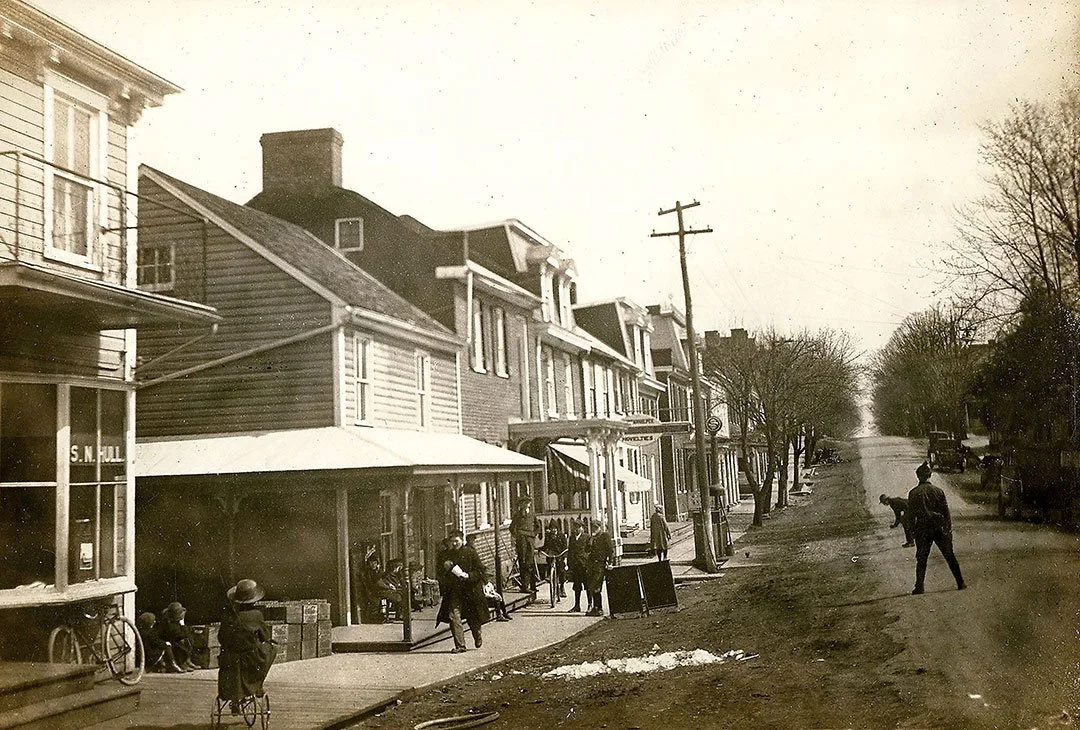On the Road
The National Road through Clear Spring in the days before pavement.
A new museum in Boonsboro pays tribute to the cross-county Route 40: The Road that Built the Nation
By Laura Forrest Hopfauf
The early days of The National Road were rugged and tough-going transportation.
Through the heart of Main Street in Boonsboro, Funkstown, Hagerstown, Clear Spring, and Hancock runs a road that carries the history of America in a way few of us recognize.
The National Road through Hancock followed the railroad and the C&O Canal.
It’s a road that goes by many names on its cross-country trek. In Washington County it’s known as Alternate 40, the Old National Pike, Route 40, Main Street, Franklin Street, and Washington Street. In other parts of Maryland it is known as Scenic Route 40, 40A, and Interstate 68. Across the country it’s known as The Old Trails Road, The National Road, Main Street of America, or The National Turnpike. But, most fittingly, it is known as The Road That Built the Nation.
The National Road Museum—the only museum in Maryland dedicated to the road—on Main Street in Boonsboro celebrates a path that has connected not just our county and state but our country for more than 200 years.
The museum leads visitors through the history of The National Road from its inception to the current day in a thought-provoking and compelling manner. Starting the journey clear back when the road was an American Indian Trail, the museum follows its route to becoming the first federally funded road in 1806 to its role in the Civil War to its fight for relevancy at the invention of the railroad then it’s subsequent resurgence with the car, and most recently its role with the implementation of by-passes and the interstate.
The National Road Museum
The new National Road Museum in Boonsboro features informative exhibits that tell the story of the nation’s first highway. Reuben Moss is the director. Photography by Mark Youngblood
The National Road Heritage Foundation invites visitors to take a historic journey along the first federally funded highway in the United States. A romance between scenic brilliance and stunning history reveals itself along the way.
Address: 214 North Main Street, Boonsboro
Hours: Saturday from 10 a.m. to 4 p.m. and every fourth Sunday from 1 p.m. to 4 p.m.
While You’re There: Visit the Boonsboro Trolley Station Museum next door; treat yourself to a great steak or seafood at Branded Chophouse or fine Italian at Jeovanis Pizzeria; grab a quick bite at Sizzlin’ Fajita or Vesta Pizzeria. Stay overnight at Inn BoonsBoro, an elegant historic boutique bed and breakfast owned by bestselling author Nora Roberts and her husband Bruce Wilder.
In addition to its historical displays, the museum preserves artifacts such as an authentic Tony Mendez painting and an original mile marker.
“We maintain all the wayside historical signs along the road. There are 52 that we maintain…including the one out front,” says Reuben Moss, director of The National Road Museum.
Other important emblems of the road such as the Casselman River Bridge and the Madonna of the Trail Monuments are along the route for those passing through today to study.
Although Route 40 isn’t often held in the same esteem as the iconic Route 66 with its tourist attractions and desert wonders, The National Road made the beginnings of western travel possible at a time it was arduous and dangerous.
“[Route] 40 was doing everything 66 did in the 1800s,” Moss says.
In the 1800s, the main streets that were part of The National Road were lined with taverns, stores, and hotels that travelers would need. Today in Washington County, many of those buildings still stand as houses and some remain as local businesses such as Inn BoonsBoro and Wilson Store in Clear Spring.
The National Road wasn’t just innovative in that it was the first road meant to connect our country town to town, it was also contained the first stretch of road to use macadam. In the 1800s the 10-mile stretch of road between Boonsboro and Hagerstown, known at the time as The Boonsborough Pike, was so difficult to travel that it would take stagecoaches up to seven hours to pass through it. Macadam was laid here to shorten that trip, connecting Boonsboro and Hagerstown on a faster, safer path.
Today The National Road, perhaps any road, isn’t held in the regard that maybe it should be. We don’t think of roads as essential to our history, as important as who was president or what technology was invented. In our daily lives, roads are overlooked. Where they came, how and why they were built, what it would be like to live without them are not really part of our collective consciousness. We drive them. We complain when there is work being done to them that slows our travel. We get upset with traffic jams.
But without roads society lacks connection, and little towns are dots on a giant map with no way to get from one point to the next. Without roads, without The National Road—the first road that sought to lead us westward—our county would be disjointed; a body with no veins.
“For much of human existence, the ability to connect with one another, improve our society, and better our lives, has been dependent on travel, in particular trails and roads,” Moss says. “The National Road today seems like just another rural road, but at one time it was the most reliable artery that allowed our 13 colonies to spread west while staying united and has played a part in many of the major events that have shaped our nation.”






